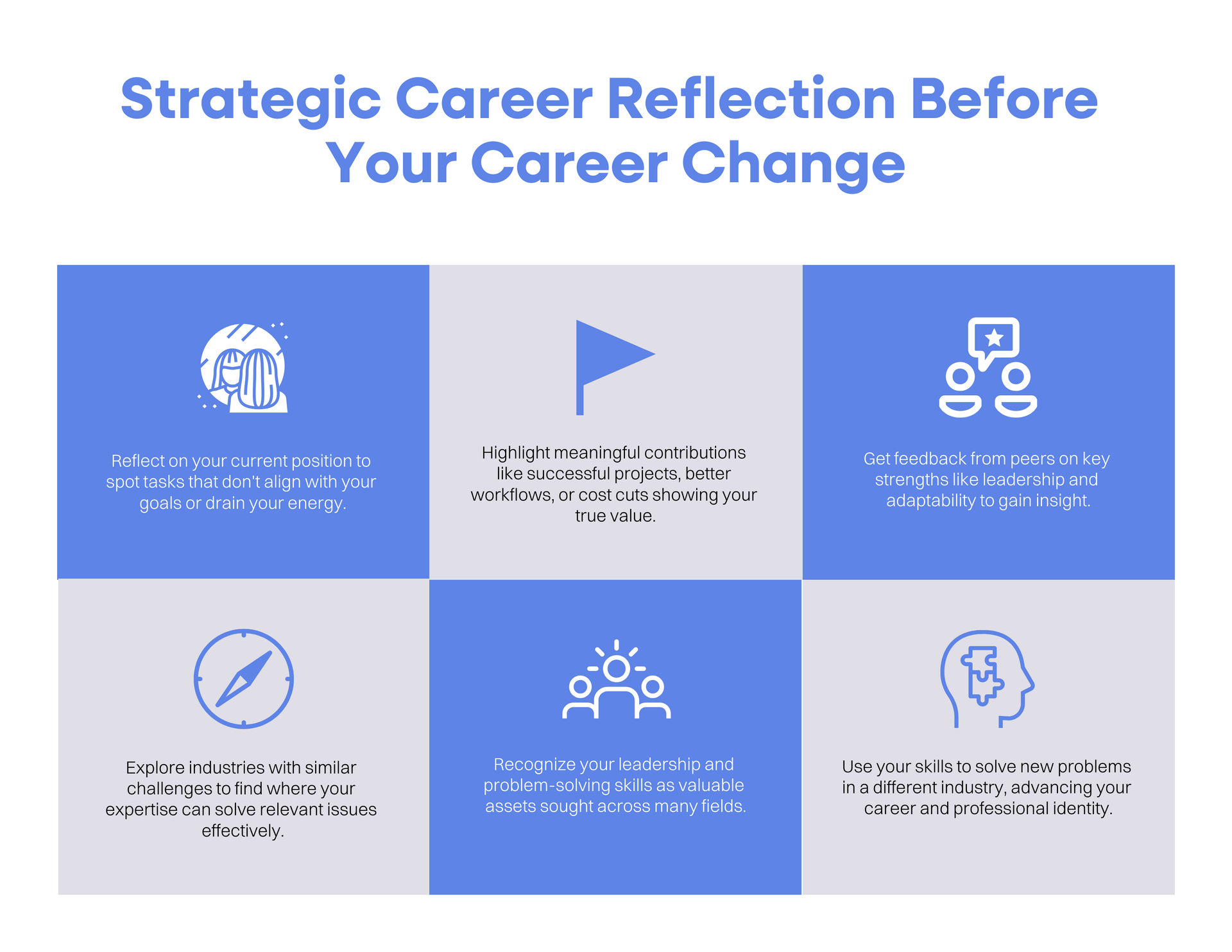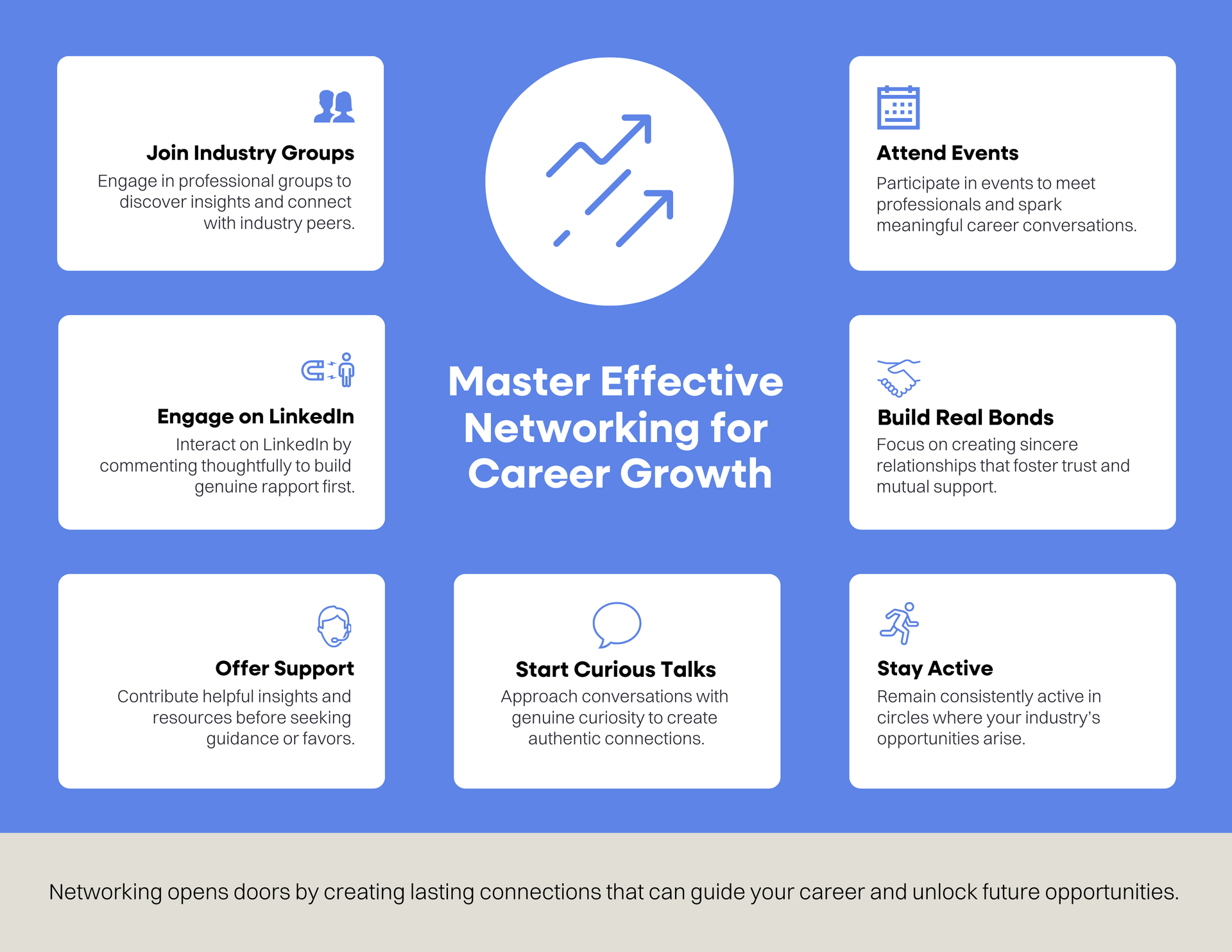How to Change Careers Without Starting Over
TL;DR
- You’re not starting over. You’re repositioning your existing experience to solve new problems.
- Audit your strengths and wins to identify what’s transferable and what needs to evolve.
- Define your target role by researching job descriptions, skills required, and industry language.
- Reframe limiting beliefs—you don’t need a new degree or to start at the bottom.
- Update your resume and LinkedIn to highlight results in language that resonates with your new field.
- Build your network strategically by commenting on target profiles before connecting and offering value first.
- Remember: You’re a cross-industry asset, not a beginner.
You’re Not a Beginner. You’re a Cross-Industry Asset.
In 2019, I made what some might call a “risky” move, leaving a stable, senior leadership role in aerospace at Boeing to enter the tech world at Amazon. From Sr. Manager of Production Engineering to Sr. Manager of Program Management in a completely different field. It wasn’t a restart, it was a pivot. And it worked because I positioned myself as someone who could solve problems using the experience I already had.
That’s what this guide is about:
how to change careers without starting over. Because the truth is, you’re likely more qualified than you think. Let’s talk about how to make a career transition, not from scratch, but from your strengths.
Introduction: Making a Career Change Without Resetting the Clock
Switching careers doesn’t mean going back to square one. The biggest challenge most career changers face is mindset. They think they’re starting over, but in reality, they’re building on years of work history, leadership, communication, and problem-solving skills. A career coach can help you identify your career path and translate your story in a way that resonates with hiring managers in a new industry.
If you’re exploring changing careers without having to do a full reboot, here’s the first step: reframe your value.
Assessing Your Current Situation
Before jumping into job postings or investing in a training program, hit pause and take stock of where you are. The goal isn’t to burn it all down, it’s to build strategically from what’s already there.
Ask yourself:
1. What part of my current job no longer aligns with where I want to go?
- Are you missing purpose, growth, or flexibility?
- Have your values or lifestyle changed, but your role hasn’t?
- Is your day-to-day work energizing, or draining?
Understanding what’s broken helps clarify what you actually want in a new career.
2. What accomplishments am I proud of, and how do they apply to a new career path?
- Think beyond titles. What results did you deliver?
- Did you:
- Launch a successful project?
- Save your company time or money?
- Build or improve a process?
- These wins are currency. Repackage them using language your new industry understands.
3. What strengths and soft skills do others consistently recognize in me?
- Leadership, communication, adaptability; these show up across industries.
- Ask colleagues or mentors:
- “What do you rely on me for?”
- “When have I added the most value to the team?”
- These responses highlight your core transferable skills.
4. What industries need those strengths?
- Research sectors with similar challenges or business models.
- Use job descriptions to identify overlap with your experience.
- Ask:
- “Who else has this problem I already know how to solve?”
- “What companies value people with my skill set?”
For me, I realized that program management, cross-functional leadership, and problem-solving weren’t just aerospace skills, they were business-critical skills. Tech companies needed them too. That insight gave me a bridge, not a reset.
Start there. Because your next move isn’t about becoming someone new, it’s about showing how who you already are solves the right problem in a new field.

Defining Your Career Path
Your career path doesn’t need to follow a straight line, but it does need to be intentional.
Clarity comes from action. The more you explore, the more confident you’ll be in your direction.
Here’s what helped me (and what I now coach others to do):
1. Review job descriptions in your target field to understand the skills required.
- Look for common themes across roles; are they asking for:
- Data analysis?
- Project management?
- Client communication?
- Industry-specific software?
Create a list of recurring skills or tools, and use it as your training roadmap for areas you don't already have experience.
2. Align your past experience and wins to those needs.
Once you’ve identified the top skills in your target field, the next step is to bridge the gap; show how your past experience already proves you can succeed.
For each skill or requirement, ask yourself:
- “Where have I done something similar?”
- “What proof do I have that I can deliver here?”
- “How can I reframe this in the language my target industry uses?”
Don’t just list tasks, highlight outcomes.
Example:
Let’s say the new role you're targeting is in Product Management in tech, and a key requirement is the ability to manage stakeholder expectations, run agile sprints, and align cross-functional teams.
From your current job in manufacturing:
Before (your original role language):
“Led a production engineering team through a tooling redesign for a commercial aircraft program, coordinating with suppliers, QA, and final assembly.”
After (translated to new industry language):
“Managed cross-functional collaboration between engineering, vendor operations, and quality teams to deliver a tooling redesign on schedule. Navigated shifting stakeholder priorities and drove iterative development cycles, resulting in a 15% reduction in rework and meeting launch deadlines.”
This example:
- Shows results (15% reduction in rework)
- Translates processes (iteration = agile, stakeholders = product owners, timelines = sprints)
- Highlights transferable skills (coordination, adaptability, decision-making under pressure)
The bottom line: you’re not starting from scratch, you’re simply reframing your past wins in a way that makes sense to a new audience.
That’s how you move from “outsider” to “obvious fit.”
3. Network to connect with successful people in your target industry.
- Focus on building relationships, not just asking for referrals.
- Start with:
- Attend in-person and virtual industry networking events.
- LinkedIn outreach (leave 10-15 meaningful comments each day on profiles in your target industry).
- Schedule in-person and virtual "coffee chats" to learn more about what working in your preferred industry is like.
- Ask:
- “What skills helped you break into this industry?”
- “What would you do differently if you were starting today?”
4. Explore freelance work, a personal project, or short-term roles to test-drive the space.
- These lower-risk options let you build proof without committing to a full-time leap:
- Volunteer in a related industry.
- Freelance for a nonprofit or startup.
- Take on part-time consulting in your current network.
- Launch a personal project related to your target role.
Think of it like this: the market isn’t asking,
“Have you done this job before?” It’s asking,
“Can you solve the problems we’re facing right now?”
Your job is to show them you’ve done just that, even if it was under a different title, in a different industry.

Overcoming Limiting Beliefs
This part is personal. For most career changers I coach, the biggest barrier isn’t a lack of skills, it’s the internal narrative that says, “I’m not qualified.”
Let’s clear that up:
- You don’t need to start at the bottom in an entry-level role.
- You don’t need a bachelor’s degree in the new field to be valuable.
- You don’t need a boot camp, unless it directly builds skills your target industry demands.
The goal isn’t to erase your past, it’s to reposition it.
Here’s the mindset shift:
You’re not changing careers because you’re lost.
You’re changing because you’ve
outgrown your current one.
To help reframe your thinking, ask yourself:
- What have I done that someone in this new field hasn’t?
- What life experience gives me a unique perspective others in this industry may lack?
- How has my past role trained me to adapt, lead, and problem-solve, core skills that matter everywhere?
Common limiting beliefs and better reframes:
| Limiting Belief | Positive Reframe |
|---|---|
| “I’ve never worked in this industry.” | “I’ve solved similar problems in a different context.” |
| “I don’t have the right degree.” | “I have real-world experience that gets results.” |
| “I’m too old to make a change.” | “I bring maturity, leadership, and strategic thinking.” |
| “I’d be starting over.” | “I’m building on a solid foundation.” |
When I transitioned from Boeing to Amazon, I didn’t pretend to be a tech insider. I leaned into my aerospace background as a strength. I pitched my ability to:
- Build scalable systems under pressure.
- Drive performance in highly regulated environments.
- Lead cross-functional programs with zero margin for error.
That was the value. It wasn’t a detour, it was the differentiator.
Bottom line:
- You don’t need to wait for permission to make a career change.
- You just need to start seeing your background as an asset, because it is.
Creating a Career Transition Plan
A good pivot doesn’t happen by accident. It happens with a plan.
Here’s how to structure yours:
- Clarify your goal
→ What kind of new career do you want? Be specific. - Audit your current assets
→ Skills, formal education, accomplishments, and projects. - Identify gaps
→ Do you need a course, training program, or certification? - Build momentum
→ Take on freelance work, attend events, start building connections. - Set realistic expectations
→ Career changes can take 6–12 months. Don’t expect overnight results.
If you need more guidance with creating and executing your career change plan, find a good career coach who can guide you.
Remember, planning keeps you moving. Momentum beats perfection every time.

Building Your Professional Network
If I had to point to one key that unlocked my new role in tech, it was this:
I got in the room.
Not just physically, but in conversations, in communities, and in circles where opportunity lived.
Here’s how to build that kind of presence:
Join Industry-Specific Spaces
These are gold mines for insight and connection.
- Local and national professional associations.
- Online communities like ExecOnline, The Forem, or Chief.
- Slack groups, Discord channels, and forums related to your target role or industry.
Pro tip: Don’t just join, engage. Ask questions. Comment on posts. Offer perspective.
Attend Meetups, Events, and Conferences
Whether virtual or in-person, these are still one of the best ways to connect with others:
- Industry panels, workshops, or alumni events.
- Local tech or professional meetups via platforms like Meetup or Eventbrite.
- Career fairs or community-led learning events.
Start conversations with curiosity, not a pitch. “What brought you to this event?” goes a long way.
Reach Out on LinkedIn (Like a Human)
Networking isn’t spamming. It’s relationship building, and it starts before the message.
Start with thoughtful comments on their posts:
- Engage with a few recent updates from your target connection.
- Leave specific, relevant comments that add value or spark conversation.
- “Really liked your take on pivoting into product management, especially the part about leveraging soft skills. I’m currently exploring that path and this helped clarify a few things.”
- Don’t just say “Great post.” Show that you actually read it.
Why this works: It makes your name familiar and builds goodwill before your message lands in their inbox.
Then, send a personalized message along with your connection request:
- Reference your comment or their post:
- “Hi [Name], I really appreciated your recent post on [topic] and left a quick comment. I’m exploring a similar transition and would love to connect and learn a bit about your journey.”
- Keep it short. People are busy. Clarity beats clever.
- Focus on learning, not asking for favors or referrals up front.
This two-step approach shows respect, builds context, and increases your chances of getting a response.
Offer Value First
Networking works best when it’s not one-sided. Try:
- Sharing relevant content or resources with people.
- Commenting insightfully on their posts.
- Offering to help with a project or volunteer effort.
The goal isn’t to “get a job.”
The goal is to
build relationships with people who can:
- Teach you the lay of the land.
- Offer referrals when the timing is right.
- Become long-term allies in your new field.
Get in the room. Stay in the conversation. That’s how doors open.
Take a look at my article on how to network as a senior level job seeker for more tips to boost your network.

Updating Your Resume and Online Profile
When I made my pivot, I didn’t just rewrite my resume, I rewrote my story and revised my personal brand.
You’re not trying to hide your past; you’re translating it for a new audience. Here’s how to approach it strategically:
Tailor Your Resume to Each Job Description
- Identify the top 3–5 skills or experiences the posting emphasizes.
- Mirror that language throughout your resume and profile.
- Use a custom summary at the top that clearly connects your background to the target role.
Example: “Operations leader with 10+ years in aerospace, now focused on optimizing tech workflows and scaling cross-functional programs.”
Use Language from the New Industry
- Swap industry-specific terms for universal or role-relevant ones.
- “Flight readiness review” → “Operational launch process”
- “MRB lead” → “Problem resolution lead across engineering + quality”
- Review job postings and LinkedIn profiles in your new field to match tone and terminology.
Focus on Outcomes: What did You Improve, Fix, or Build?
- Use metrics when possible:
- Reduced downtime by 18%
- Cut launch delays by 3 weeks
- Onboarded 15 new team members across two departments
- Emphasize measured impact, not just duties.
Use LinkedIn to Show Thought Leadership or Share Your Personal Projects
- Post insights from your transition process (you’ll attract others in the same boat)
- Share case studies, frameworks, or lessons from freelance or volunteer projects
- Include portfolio links, blogs, or presentations in your Featured section
Bottom line:
This isn’t about padding your resume, it’s about
positioning your past to solve problems in a
new role.
Done right, your resume doesn’t say,
“I’m changing careers.”
It says,
“I’ve already been solving the kinds of problems you need help with, just in a different context.”
Check out my guide on how to write a great resume while avoiding common pitfalls to ensure yours is ready.

Gaining New Skills and Experience
You don’t need to quit your full-time job to gain new skills. Use your spare time to experiment and grow.
Here’s how:
- Volunteer or consult in a new field.
- Take one course that moves you closer to your goal.
- Build a personal project that showcases your skill set.
- Join a project management community and offer to help with events.
This is how you create credibility before the job title changes.
Switching Careers Without Starting Over
Here are a few examples of careers without the need for a complete reset:
- Customer Success – Leverage communication + leadership
- Project Management – Great for those with coordination experience
- HR or Talent – For those who love people ops and building teams
- Operations – If you’re a systems-thinker who gets stuff done
- Event Planning – Great for folks with logistical and networking skills
Look for jobs with great prospects, high demand, and a match for your strengths; not just your degree.
Achieving Your New Career
The first step is the hardest, but once you’re in motion, the right pieces start to align. Momentum matters more than perfection.
As a career coach, here's what I tell my clients when they start doubting themselves:
Your value isn’t erased just because your title changes
- You’re not “starting over,” you’re repositioning what you already bring.
- Titles shift. Impact, experience, and leadership carry over.
- Employers hire for outcomes, not titles.
You bring life experience, transferable skills, and a fresh lens
- Years of problem-solving, leading teams, adapting to change. It all matters.
- Your nonlinear path gives you a perspective most others don’t have.
- This is often what sets you apart in a crowded field.
Hiring managers don’t need someone who checks every box
- They need someone who can step in, learn fast, and solve real business problems.
- Most job postings are wishlists, not hard requirements.
- Focus your pitch on:
- How you think
- How you work with others
- How you’ve solved similar problems before, even in a different context
You’re already that person
- You’ve led teams, launched projects, delivered results, and navigated change.
- Now, it’s about telling that story in the language of your new field.
This isn’t about proving you belong, it’s about realizing you always have.
You’re not an outsider. You’re a
cross-industry asset with the track record to back it up.
Keep moving forward. The more conversations you have, the more momentum you build, and the closer you get to the opportunity that matches your next chapter.
FAQ: Making a Career Change Without Starting Over
Do I need to go back to school or get a new degree to switch industries?
Not always. Unless a role has strict credentialing (like law or medicine), real-world experience, transferable skills, and problem-solving ability often matter more than formal education. Courses and certifications can help, but only if they directly support your pivot.
What if I’ve never worked in my target industry before?
That’s more common than you think. Focus on the problems you’ve already solved that are similar. The key is reframing your past work in language your new field understands. You’re not an outsider, you’re a cross-industry asset.
How long does a career transition usually take?
For most mid- and senior-level professionals, it takes 6–12 months. Plan for the long game. Build momentum through small wins, such as freelance work, networking, and learning, and stay consistent.
How do I get noticed by people in my target field?
Start by engaging with them online. Leave thoughtful comments on their posts. Share insight, not just praise. Once you’ve built some visibility, send a personalized connection message. Relationships start before the inbox.
What should I highlight on my resume and LinkedIn?
Focus on outcomes over tasks. Show how you improved, built, or solved something, and match your language to the new industry. Don’t erase your past. Translate it.
Is working with a career coach worth it?
If you’re stuck, overwhelmed, or unsure how to position yourself for a pivot—yes. A coach can help you clarify your direction, update your story, and build a targeted plan that shortens the learning curve.
Final Thoughts
You don’t have to change careers by going back to square one. You just need to reposition what you already bring to the table.
Whether you’re transitioning from manufacturing to marketing, sales to strategy, or aerospace to tech (like I did), you’re not a beginner.
You’re a cross-industry asset.
Need some help with your career change? Apply now to work with me!

Citations:
- Broda Coaching Internal Client Data. (2025) Career Change Metrics
- National Career Development Association. (2024). Leveraging Transferable Skills in Career Change.
- SHRM. (2024). Career Transitions: Key Considerations for Mid-Career Professionals.
- Harvard Business Review. (2024). How to Change Careers Without Starting From Scratch.
- LinkedIn Workforce Report. (2024). Top Career Pivots by Industry and Skill Set.






